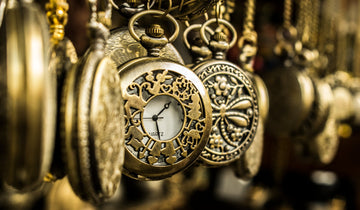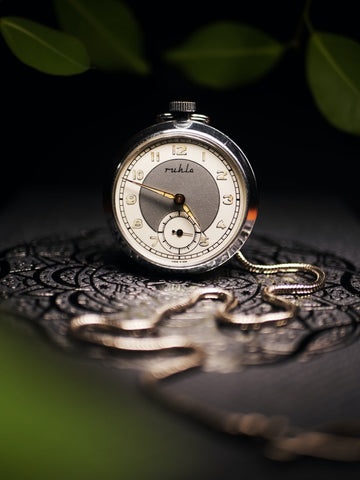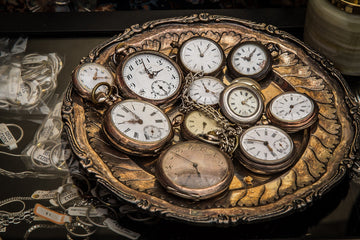Antique Pocket Watch Identification Guide
by Ayesha Ghazanfar on Oct 09, 2020

Antique pocket watches, created by skillful watchmakers of the 18th-19th centuries, not only measured the passage of time but were also masterpieces of decorative craftsmanship, as well as luxurious accessories that demonstrated the high status of the owner. This accessory is still very attractive. That is why humanity's interest in this subject does not fade away, and it does not go out of fashion. But how to know that your pocket watch is antique? In this article, we will share the criteria of Antique Pocket Watch Identification:

How to Identify an Antique Pocket Watch?
Antique Pocket Watch Identification depends on the following criteria:
- Age
- craftsman or manufacture
- historical value
- artistic value
- uniqueness
- award
- personalized elements.
So let's discuss them in detail:
Identify the manufacturers
When identifying a watch, look at the dial to identify the manufacturer. If there is no company name on the dial, look for this information on the pocket watch's backplate. Determine which country and/or city the watch originated from. The name engraved on the back means "signature." After determining the place of manufacture, see which companies made watches in this city. Remember: some of the "hard-to-identify" watches are valuable collectibles. Therefore, it is important to be able to identify them.

It is necessary to study the design. You must consider the size, number, and location of the gems, the shape, the layout of the disc (full or 3/4), the disc parts' location, screws, the shape of the adjuster, etc.
Identify the age by Serial Number
After establishing the manufacturer's name, you should be interested in the age of the pocket watch. This information can be obtained using the serial number written on the back of the case. It is often difficult to establish an exact age.
Many distinctive features make it possible to establish the age of antique pocket watches made before 1850. Manual winding and arrow regulators contain essential clues in determining the age. However, no part in isolation can be considered sufficient fact to determine the age of the watch. The watch must be viewed as a whole.
Identify the country in which they were produced. For example, an English silver watch will have a stamp on the case, which will make it possible to refer to the London List of Stamps to determine the date of production after 1697.

Identify the Type of Antique Pocket Watch
Your pocket watch dial, case, and face determine what type of pocket watch you have.
-
Demi-hunter case: This is a European style with a tiny window on the cover. The windows help you to tell the time without opening the watch.
-
Hunter case: This watch comes with a round metallic cover that is attached to a spring hinge that can be closed. The metallic cover closes to protect the crystal on the dial. The stem and crown, or the winding mechanism, are located at the 3' o clock position on the watch.
-
Military pocket watches: A century ago, pocket watches were a standard issue for the military in some regions. They came with simple and sophisticated designs.
-
Open-face: Such type of watches come without a cover for the protection of crystal, glass on the dial. The setting stem, winding, and crown are located at the 12' o clock position on the watch.
-
Pair-cased: The unique design of the 18th century is an essential open-face pocket watch placed inside a hunter case. The inner case is removable for winding the watch and then replaced in the outer case for protection.
-
Railroad-pocket watches: Railroad watched are specially designed for railroad workers. Those made after 1908 usually comes with an open-face style.
-
Stainless steel watched: The case is made from special stainless steel for these pocket watches.
- Wristwatch conversion: Formerly a wristwatch, that is now converted into a pocket watch to meet the demands of the users.

Identifying the Watch Movements
The machines parts of the pocket watch are known as movements. Many movements were placed in cases made several years before or after the movement itself. The watch case, in which the movement is located, is not a good clue to identifying the original movement. It was common practice for manufacturers to hand over movements to jewelers and case manufacturers. The buyer himself chose the case for the movement. This explains why you can find an expensive movement in a cheap case and vice versa.

The following types will help you to identify the movement:
-
Key-wind, key-set: These watches were in fashion from the 1600s through the mid-1800s. They need a special key to wind and set the watch.
-
Stem-wind, stem-set: This type eliminates key and introduced stem to wind and set the watch. This model was most commonly used in the 1850s.
-
Stem-wind, lever-set: The railroad watches in the 1900s have an open dial cover to access the special setting lever.
- Stem-wind, pin-set: This is a modern technique used in the watches. You need to press the pin and set the time before releasing it.
Comparing the models
Some watches can be identified by comparing models from each company until the correct model is found. Start by measuring the clock and then compare different shapes and styles. The winding up and regulator of hands can also be a hint. The general arrangement of a piece in relation to gemstone jewelry: on the dial or watch case, and the style of the adjusters, can help determine the manufacturer of the piece.
The numbers on the watch case should not be taken as clues because many of the good watches could change the case and therefore have different kinds of numbers.

Proper Care Of Your Pocket Watch
In the old days, a lot of pocket watches were produced. Therefore, they have successfully survived to this day. A pocket watch needs proper care. The mechanism of antique watches should be regularly lubricated and monitored for its normal technical condition. It is better to entrust this business to professional restorers. The ticking devices of the past centuries are quite capricious and sensitive due to their venerable age. An improperly selected lubricant can damage the functionalities of your watch.
Daily care recommendations:
- the air humidity in the room where the watch is stored should be no more than 60%;
- the temperature should be about 22 degrees;
- heat sources should not be near the place where you keep your pocket watch;
- water ingress on the watch case is unacceptable; protect them from dust and dirt; do not touch the dial with your hands;
- wipe the protective glass and case with a cloth;
- protect against possible damage such as scratches; protect from the sun, because in the old days, mostly natural paints were used for painting, fading in the sun, which would ruin the appearance of an antique pocket watch;
- wind the mechanism very carefully so that the spring does not burst; once every few years, have a watchmaker serviced your precious property
Conclusion
If you want to evaluate your pocket watch, you must follow the above tips or consult an expert if needed.
On our site, you will find pocket watches and their accessories. Male and female, simple shapes and decorated with stones and paintings. Just look through the catalog and place an order for the model you like.
References
Howcast. (2010, June 03). How to Care for a Pocket Watch. Retrieved from https://www.howcast.com/videos/384325-how-to-care-for-a-pocket-watch
Admin. (2019, March 17). Types of watch movements. Retrieved from https://www.pocketwatches.org.uk/types-of-watch-movements/
Pocked Watches (n.d.). Home. Retrieved October 09, 2020, from https://www.pocketwatches.com/pocket-watch-types-i293




